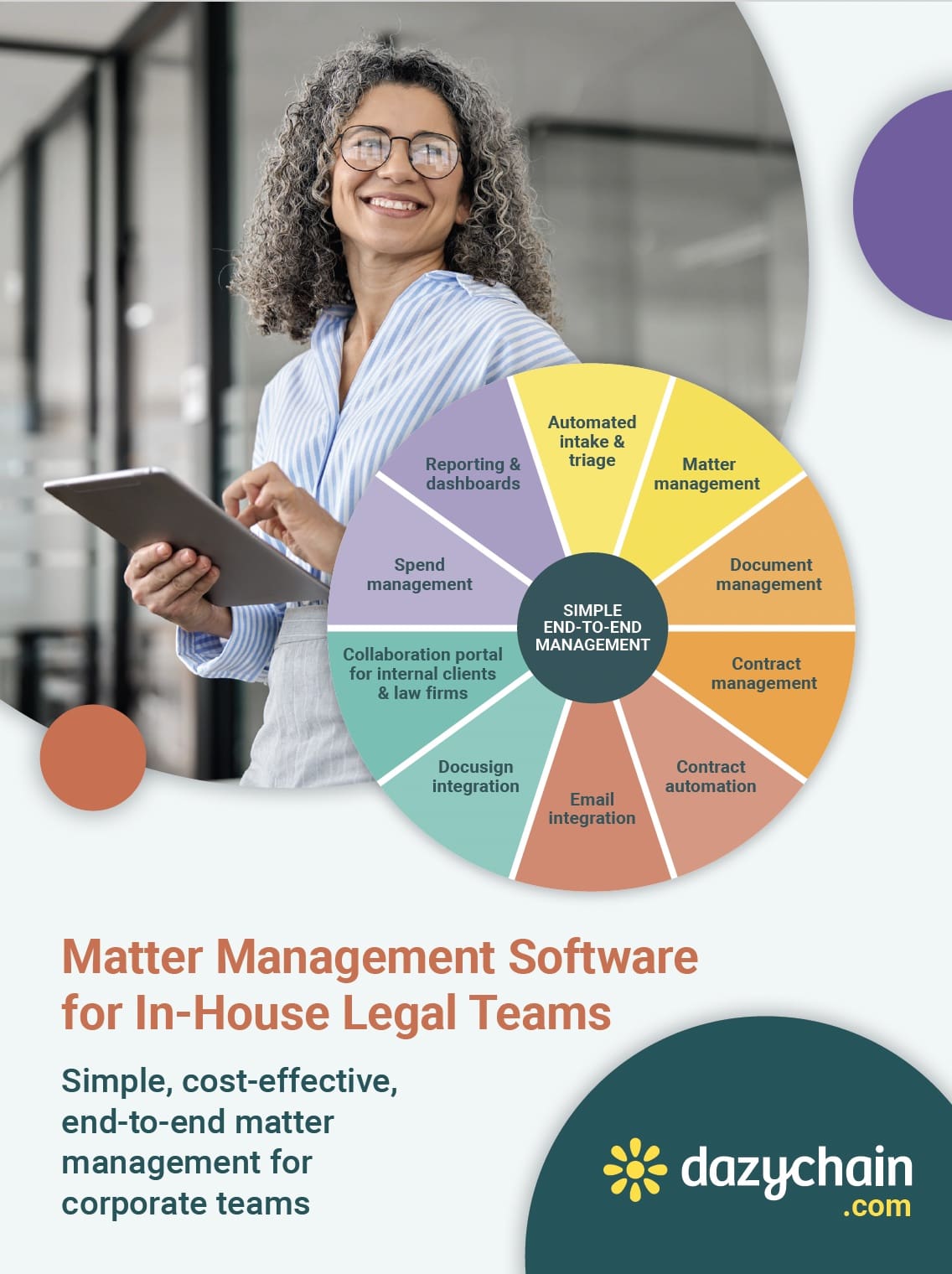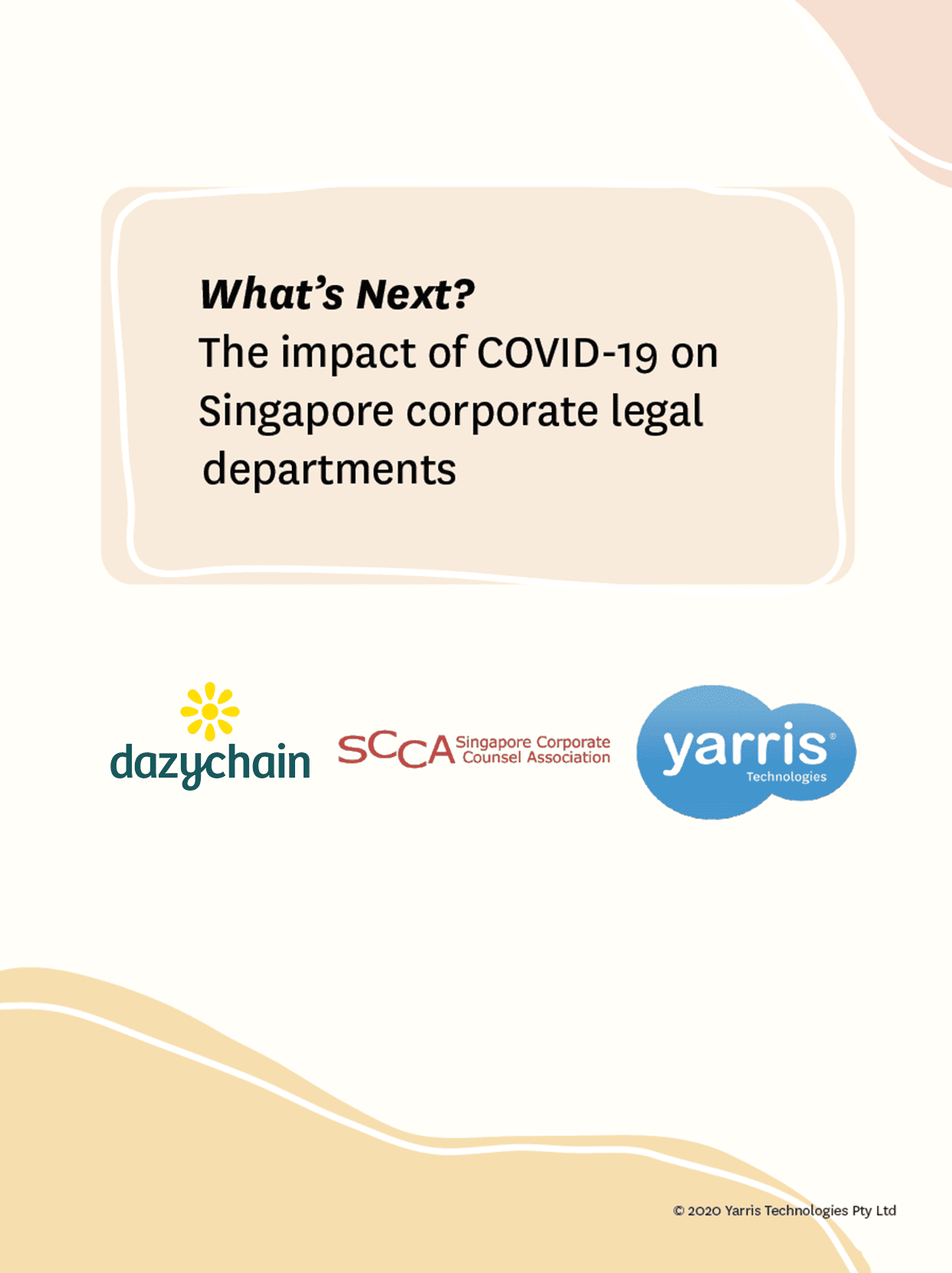The 5 steps to choosing legal tech
Dr Katherine King
Chief Executive Officer
Dazychain Co-founder
Introduction
Choosing legal tech doesn’t have to be a mystery. IT procurement experts have developed a formula for purchasing software to reduce the mystery, and to help you plan the process efficiently. Planning, discussion and documentation can help you get through the selection and implementation process quickly, efficiently and comprehensively. This guide is designed to help you structure your process so you don’t miss anything.
This article discusses the five steps to follow on your legal tech journey:
- Get organised
- Define your current problems
- Specify your requirements
- Meet with the providers
- Make the decision

Create a weekly or bi-weekly project working group, involving as many people on your team as practical. It helps to have a range of people from your team, and your business, for example a representative from the IT team, a couple of members of the legal team and perhaps a paralegal. Weekly meetings will help you structure the work you need to do together to understand your challenges, create requirements, meet with vendors, and to make a selection. Each person brings their own perspective and experience.
The From/To analysis
The first step is to consider where you are now, and where you want to be. The simple From/To analysis helps you and the team to clarify where you’re going and why. Here are some of the central questions.
From:
- Where are we now?
- What are we doing well?
- What are we not doing so well?
- What do we need to change?
To:
- Where do we want to be?
- What do we need?
- What do our ‘customers’ need?
- What does that look like?
- How will it work?
- What is realistic? What is optimistic?
- How long do we need it to take to make the change?
- How do we bring everyone on the journey?

Following are some of the challenges most legal teams are facing as they consider their tech needs. Asking yourselves these questions helps you to clarify your current problems, then to indicate your software requirements. The best way to attack this is to write it all down on a spreadsheet. This may be tackled in one session, or several sessions where you dig deeper into the issues.
- What’s taking the most time?
- Where are we most inefficient?
- What do our customers complain about?
- What is the level of transparency into our work?
- What’s most affecting the budget?
- What happens when someone takes annual leave? Or leaves the company?
- Where are our key documents stored? Are they located centrally?
- How quick can we turn around work?
- Can our customers serve themselves for repetitive tasks?
- Do we understand our current resourcing needs?
- What are our most common work types and working patterns?
- What are our time consuming, manual processes?
- How do we locate key documents?
- Can we reuse advice, contracts, matters?
- How do we report now? Is it difficult or time consuming? Are our reports useful?
- What should we be reporting on?
- Do we have a detailed record of expiring contracts?
- How are we interacting with our external law firms or key clients?

Brainstorm
When you’re thinking of your requirements, it’s great to brainstorm a big list with your team, with no boundaries or exclusions. The sky’s the limit! Make sure you transcribe all of the ideas, because you will inevitably forget something.
Prioritise
Now it’s time to go back and prioritise the list, with the most important starting on top of the list. You’ll be surprised that what’s important to one person is not so important to others. For example, the General Counsel may need detailed reporting for her CEO and CFO, while the team members are keener on intake forms. The group needs to work together to prioritise the list on a spreadsheet to ensure that all voices are heard, and so you don’t create a disaffected group whose needs are unmet.
What product features do we need?
Features vary somewhat between the different products, but for the most part, matter management and legal operations software products have some combination of the following modules:
- Intake: forms for internal clients to fill out to create requests for legal advice or services
- Self-service: a feature where internal clients can fill out a form, then receive a templated document with key areas filled in, for activities such as NDAs or employment contracts
- Document management: a repository for saving, creating, editing, sharing, updating and deleting documents and emails
- Integrations: links to some of your most important current tools, such as Outlook, Docusign and Sharepoint
- Knowledge management: the ability to structure your matters into folders, worktypes, by business units, collaborators and matter numbers, and then, most importantly, to find it again
- Matter management: the process of creating and standardizing matters with key information used to identify, categorize, find and report on matters
- Contract management: structuring contracts to enable the understanding of the contracts start date, review date, end date, internal clients and next actions,
- Reporting: dashboards and reports bring transparency and information that enables users to understand what has happened, what is happening now, and predict what will happen in the future
- E-billing and financial reporting: for measuring, monitoring and analyzing spend on external legal firms
- Security: single sign on, multi factor authentication

Do we have to have it?
To keep on top of the whole process, you can now start to add column to your spreadsheet, with each requirement listed in priority order with a column for each provider and a column for a code that includes:
- Must have: the platform must do this out of the box with little configuration required, and would be used most days
- Nice to have: lower on the list of requirements, but would be used by the team at least semi-regularly
- Need it now: this functionality would be part of the system at the outset
- Need it later: this functionality is required, but only when we have the system set up and we know how to use it – this is often the case with functionality such as intake, self-service and e-billing, which are often added in phases.
What kind of data collection and reporting do we require?
Add information to your requirements that specifies the types of data you want to collect, and the reports you’d like to create in the system. Ask yourself these questions:
- What data do I need to collect?
You’ll need to enter some data into the system when you create matters. Keeping it simple is best, so give some thought to key data you do want to collect, such as the internal client you’re working with, their business unit, the type of matter, matter number, region, and the associated risk the matter might create. - What am I trying to tell people about my team? What are the most important things we want to report on? This might be variables such as the number of matters, duration of matters, matters by worktype, by cost, by budget, by provider, risk, compliance, strategic contribution to the organisation, the value of the contracts we create, the amount of commercial advice we provide.

How secure are the vendors’s systems?
Verified security is a fundamental requirement for legal tech to ensure your business continuity, customer satisfaction, and privacy. No one wants to meet around a table to discuss a ransomware payment or how you will inform your customers about a data breach. Provider security is usually explored in partnership with your IT team as part of the process when you are comparing your last providers. It’s important to require:
- ISO 27001 certification: this certification is externally audited and examines the quality and dissemination of an organization’s Information Security Management System, which is a set of policies and procedures designed to enforce information and data security
- SOC2 certified: SOC2 takes the process a step further by including an accounting audit to test the veracity of the security approach
- Cloud based certifications: activities such as an AWS Well-Architected review or external security assessment
- External testing and auditing: penetration tests and network vulnerability scans should be conducted regularly and available for your IT team to review.
What will the system cost? What is included?
The cost of legal tech generally depends on the size of your team and the level of complexity you want in your system. While your budget may vary depending on your company’s resources, it’s important to consider that you might end up paying for a lot of functionality that you won’t actually use. Functionality outside your requirements list may be expensive, difficult to implement and poorly regarded by your internal customers. The old adage of keeping it simple applies here.
It’s advisable to discuss your budget with the team, your manager, and/or the CFO and the IT team. Each group will have opinions and will value the consultation. You’ll also need to consider the practicalities of the vendor’s billing cycle and contract length.
Pricing for legal tech can be mysterious and it’s important to dig in deep to understand what is included in the quoted price. Hidden costs for consulting, configuration, single sign on, extra users, training, document migration or integrations can blow your budget if you forget to ask.

Researching providers
Researching providers is generally the easy part. You can search on the internet, ask your colleagues, attend conferences, and visit websites such as CLOC, ACC, and the College of Law. Providers are keen to meet you, often more than once, to find out about your needs and to build a relationship. Most providers will give a demonstration and enable you to use a trial system or ‘playpen’.
To save time, you can present providers with a list of your requirements before the first meeting. In response, they can tailor the discussion and demonstration to your needs, which saves time for everyone. In particular it means that it’s clear when a provider does not have the functionality you have requested on the requirements list.
It’s a little proscribed, but it’s important to check through your requirements list and ask for a demonstration of those things that are the most important on your list during your meeting with the providers.
Investigate the change management options
Although the providers don’t like to tell you so, much of the legal tech performs a similar role, and it’s all a lot more similar than it is different. Where a vendor really distinguishes themselves is in the support for you and your team as you implement, launch, train and embed the system. Providers vary in their consulting services and in the quality of their training and support programs. They also vary in price. Some charge extra for these services, while others include these services in their contracts.
It’s best to ask about the time involved and the cost of delivering the following activities:
- Consulting
- Requirements gathering
- Configuring the system
- Communication plan
- Phased launch
- Training
- Support
- Ongoing consultation, configuration and system development
Is the company a startup?
While it may be innovative and interesting, a startup comes with a range of risks and threats that you may need to investigate. Determine if the provider company is stable, well-established and solvent. If a company becomes insolvent or closes, your data may be at risk and you and your internal clients may be severely inconvenienced. Can you download the data yourself? Or dose it take consulting hours and payment to get your data back?

Add all the answers from the providers to your spreadsheet, one in each column, so you can make an ‘apple to apples’ comparison. Apply a weighting for particularly important functionality. Compare functionality, not from memory, but using the data. Compare the customer support features in detail. Then compare the prices. Score each provider.
When you make your final decision, ensure that the inclusions are clearly specified in the contract and that the timeline is included in the arrangements. Ask for a project plan for the implementation, training, handover and support components of your project.
Stay in touch with your project team to support the change, and meet regularly to embed the new system and to consider how it can evolve with your team over time.
References
People who have thought of all of this before include:
- CLOC: https://cloc.org/wp-content/uploads/2019/10/What-is-Legal-Ops_Oct2019-FINAL.pdf
- Centre for Legal Innovation: https://www.cli.collaw.com/
- The College of Law: https://www.collaw.edu.au/news/2020/08/27/the-legal-operations-role-is-indispensable-to-today-s-law-firms-as-well-as-to-legal-departments
- The Dazychain team: www.dazychain.com
The 5 steps to choosing legal tech
Dr Katherine King
Chief Executive Officer
Dazychain Co-founder
Introduction
Choosing legal tech doesn’t have to be a mystery. IT procurement experts have developed a formula for purchasing software to reduce the mystery, and to help you plan the process efficiently. Planning, discussion and documentation can help you get through the selection and implementation process quickly, efficiently and comprehensively. This guide is designed to help you structure your process so you don’t miss anything.
This article discusses the five steps to follow on your legal tech journey:
- Get organised
- Define your current problems
- Specify your requirements
- Meet with the providers
- Make the decision

Create a weekly or bi-weekly project working group, involving as many people on your team as practical. It helps to have a range of people from your team, and your business, for example a representative from the IT team, a couple of members of the legal team and perhaps a paralegal. Weekly meetings will help you structure the work you need to do together to understand your challenges, create requirements, meet with vendors, and to make a selection. Each person brings their own perspective and experience.
The From/To analysis
The first step is to consider where you are now, and where you want to be. The simple From/To analysis helps you and the team to clarify where you’re going and why. Here are some of the central questions.
From:
- Where are we now?
- What are we doing well?
- What are we not doing so well?
- What do we need to change?
To:
- Where do we want to be?
- What do we need?
- What do our ‘customers’ need?
- What does that look like?
- How will it work?
- What is realistic? What is optimistic?
- How long do we need it to take to make the change?
- How do we bring everyone on the journey?

Following are some of the challenges most legal teams are facing as they consider their tech needs. Asking yourselves these questions helps you to clarify your current problems, then to indicate your software requirements. The best way to attack this is to write it all down on a spreadsheet. This may be tackled in one session, or several sessions where you dig deeper into the issues.
- What’s taking the most time?
- Where are we most inefficient?
- What do our customers complain about?
- What is the level of transparency into our work?
- What’s most affecting the budget?
- What happens when someone takes annual leave? Or leaves the company?
- Where are our key documents stored? Are they located centrally?
- How quick can we turn around work?
- Can our customers serve themselves for repetitive tasks?
- Do we understand our current resourcing needs?
- What are our most common work types and working patterns?
- What are our time consuming, manual processes?
- How do we locate key documents?
- Can we reuse advice, contracts, matters?
- How do we report now? Is it difficult or time consuming? Are our reports useful?
- What should we be reporting on?
- Do we have a detailed record of expiring contracts?
- How are we interacting with our external law firms or key clients?

Brainstorm
When you’re thinking of your requirements, it’s great to brainstorm a big list with your team, with no boundaries or exclusions. The sky’s the limit! Make sure you transcribe all of the ideas, because you will inevitably forget something.
Prioritise
Now it’s time to go back and prioritise the list, with the most important starting on top of the list. You’ll be surprised that what’s important to one person is not so important to others. For example, the General Counsel may need detailed reporting for her CEO and CFO, while the team members are keener on intake forms. The group needs to work together to prioritise the list on a spreadsheet to ensure that all voices are heard, and so you don’t create a disaffected group whose needs are unmet.
What product features do we need?
Features vary somewhat between the different products, but for the most part, matter management and legal operations software products have some combination of the following modules:
- Intake: forms for internal clients to fill out to create requests for legal advice or services
- Self-service: a feature where internal clients can fill out a form, then receive a templated document with key areas filled in, for activities such as NDAs or employment contracts
- Document management: a repository for saving, creating, editing, sharing, updating and deleting documents and emails
- Integrations: links to some of your most important current tools, such as Outlook, Docusign and Sharepoint
- Knowledge management: the ability to structure your matters into folders, worktypes, by business units, collaborators and matter numbers, and then, most importantly, to find it again
- Matter management: the process of creating and standardizing matters with key information used to identify, categorize, find and report on matters
- Contract management: structuring contracts to enable the understanding of the contracts start date, review date, end date, internal clients and next actions,
- Reporting: dashboards and reports bring transparency and information that enables users to understand what has happened, what is happening now, and predict what will happen in the future
- E-billing and financial reporting: for measuring, monitoring and analyzing spend on external legal firms
- Security: single sign on, multi factor authentication

Do we have to have it?
To keep on top of the whole process, you can now start to add column to your spreadsheet, with each requirement listed in priority order with a column for each provider and a column for a code that includes:
- Must have: the platform must do this out of the box with little configuration required, and would be used most days
- Nice to have: lower on the list of requirements, but would be used by the team at least semi-regularly
- Need it now: this functionality would be part of the system at the outset
- Need it later: this functionality is required, but only when we have the system set up and we know how to use it – this is often the case with functionality such as intake, self-service and e-billing, which are often added in phases.
What kind of data collection and reporting do we require?
Add information to your requirements that specifies the types of data you want to collect, and the reports you’d like to create in the system. Ask yourself these questions:
- What data do I need to collect?
You’ll need to enter some data into the system when you create matters. Keeping it simple is best, so give some thought to key data you do want to collect, such as the internal client you’re working with, their business unit, the type of matter, matter number, region, and the associated risk the matter might create. - What am I trying to tell people about my team? What are the most important things we want to report on? This might be variables such as the number of matters, duration of matters, matters by worktype, by cost, by budget, by provider, risk, compliance, strategic contribution to the organisation, the value of the contracts we create, the amount of commercial advice we provide.

How secure are the vendors’s systems?
Verified security is a fundamental requirement for legal tech to ensure your business continuity, customer satisfaction, and privacy. No one wants to meet around a table to discuss a ransomware payment or how you will inform your customers about a data breach. Provider security is usually explored in partnership with your IT team as part of the process when you are comparing your last providers. It’s important to require:
- ISO 27001 certification: this certification is externally audited and examines the quality and dissemination of an organization’s Information Security Management System, which is a set of policies and procedures designed to enforce information and data security
- SOC2 certified: SOC2 takes the process a step further by including an accounting audit to test the veracity of the security approach
- Cloud based certifications: activities such as an AWS Well-Architected review or external security assessment
- External testing and auditing: penetration tests and network vulnerability scans should be conducted regularly and available for your IT team to review.
What will the system cost? What is included?
The cost of legal tech generally depends on the size of your team and the level of complexity you want in your system. While your budget may vary depending on your company’s resources, it’s important to consider that you might end up paying for a lot of functionality that you won’t actually use. Functionality outside your requirements list may be expensive, difficult to implement and poorly regarded by your internal customers. The old adage of keeping it simple applies here.
It’s advisable to discuss your budget with the team, your manager, and/or the CFO and the IT team. Each group will have opinions and will value the consultation. You’ll also need to consider the practicalities of the vendor’s billing cycle and contract length.
Pricing for legal tech can be mysterious and it’s important to dig in deep to understand what is included in the quoted price. Hidden costs for consulting, configuration, single sign on, extra users, training, document migration or integrations can blow your budget if you forget to ask.

Researching providers
Researching providers is generally the easy part. You can search on the internet, ask your colleagues, attend conferences, and visit websites such as CLOC, ACC, and the College of Law. Providers are keen to meet you, often more than once, to find out about your needs and to build a relationship. Most providers will give a demonstration and enable you to use a trial system or ‘playpen’.
To save time, you can present providers with a list of your requirements before the first meeting. In response, they can tailor the discussion and demonstration to your needs, which saves time for everyone. In particular it means that it’s clear when a provider does not have the functionality you have requested on the requirements list.
It’s a little proscribed, but it’s important to check through your requirements list and ask for a demonstration of those things that are the most important on your list during your meeting with the providers.
Investigate the change management options
Although the providers don’t like to tell you so, much of the legal tech performs a similar role, and it’s all a lot more similar than it is different. Where a vendor really distinguishes themselves is in the support for you and your team as you implement, launch, train and embed the system. Providers vary in their consulting services and in the quality of their training and support programs. They also vary in price. Some charge extra for these services, while others include these services in their contracts.
It’s best to ask about the time involved and the cost of delivering the following activities:
- Consulting
- Requirements gathering
- Configuring the system
- Communication plan
- Phased launch
- Training
- Support
- Ongoing consultation, configuration and system development
Is the company a startup?
While it may be innovative and interesting, a startup comes with a range of risks and threats that you may need to investigate. Determine if the provider company is stable, well-established and solvent. If a company becomes insolvent or closes, your data may be at risk and you and your internal clients may be severely inconvenienced. Can you download the data yourself? Or dose it take consulting hours and payment to get your data back?

Add all the answers from the providers to your spreadsheet, one in each column, so you can make an ‘apple to apples’ comparison. Apply a weighting for particularly important functionality. Compare functionality, not from memory, but using the data. Compare the customer support features in detail. Then compare the prices. Score each provider.
When you make your final decision, ensure that the inclusions are clearly specified in the contract and that the timeline is included in the arrangements. Ask for a project plan for the implementation, training, handover and support components of your project.
Stay in touch with your project team to support the change, and meet regularly to embed the new system and to consider how it can evolve with your team over time.
References
People who have thought of all of this before include:
- CLOC: https://cloc.org/wp-content/uploads/2019/10/What-is-Legal-Ops_Oct2019-FINAL.pdf
- Centre for Legal Innovation: https://www.cli.collaw.com/
- The College of Law: https://www.collaw.edu.au/news/2020/08/27/the-legal-operations-role-is-indispensable-to-today-s-law-firms-as-well-as-to-legal-departments
- The Dazychain team: www.dazychain.com










